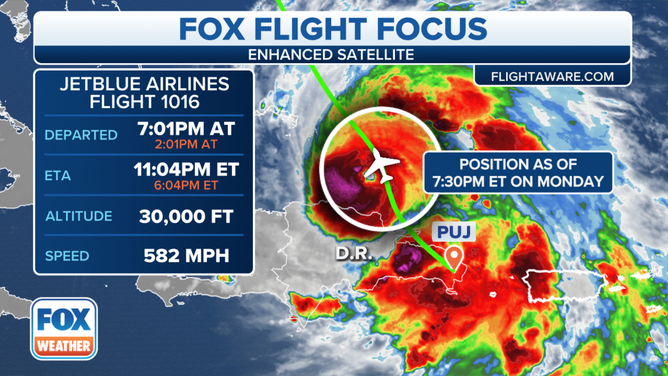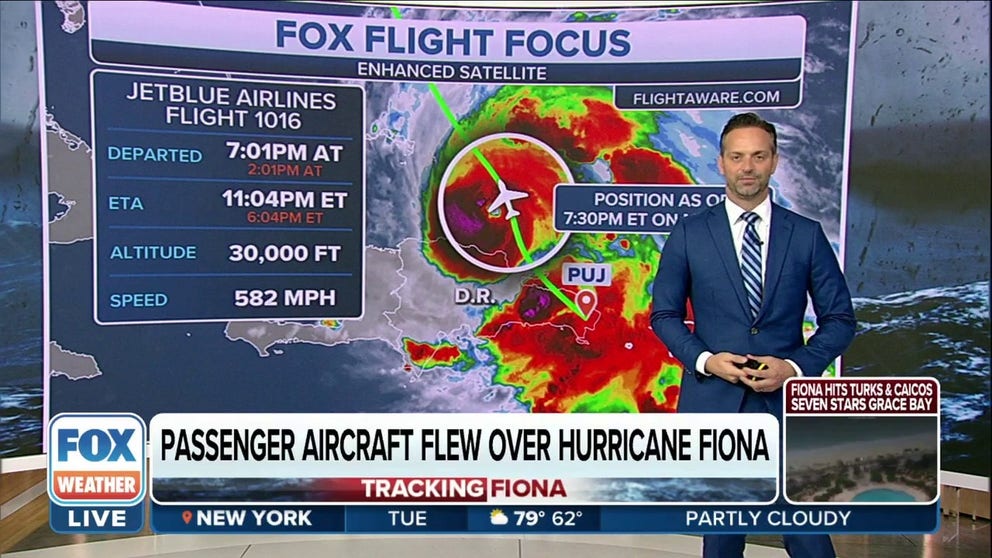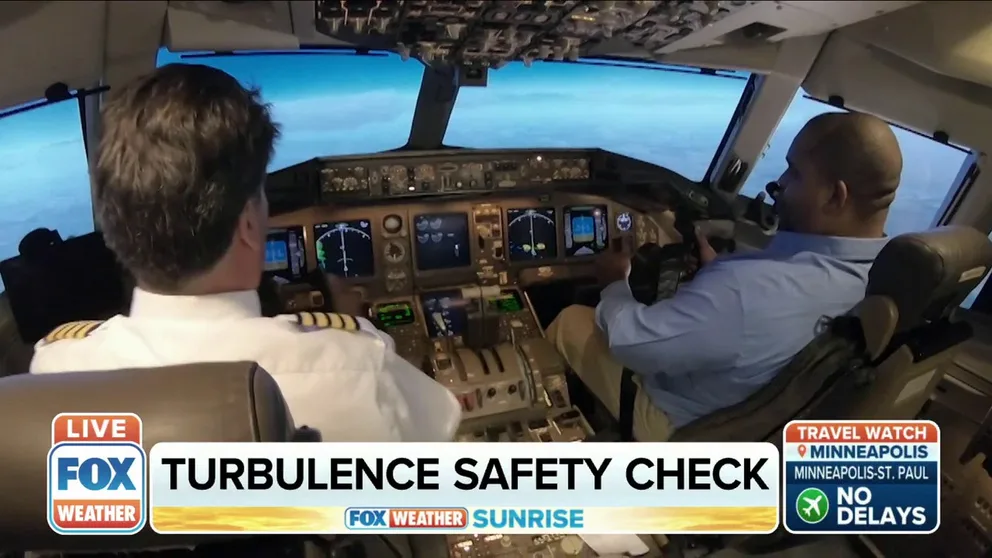JetBlue flight departing Dominican Republic flies above deadly Hurricane Fiona
JetBlue flight 1016 was originally supposed to depart the tourist destination around 2 p.m. Monday, but because of Hurricane Fiona, the flight was delayed by five hours
JetBlue releases statement after flight flies above Hurricane Fiona
JetBlue releases a statement after one of its planes flew over Hurricane Fiona.
PUNTA CANA, Dominican Republic - A JetBlue flight from Punta Cana, Dominican Republic to Newark, New Jersey flew over deadly Hurricane Fiona as the intensifying Category 3 hurricane pulled away from the Caribbean island on Monday night.
JetBlue flight 1016 was originally supposed to depart the tourist destination around 2 p.m. Monday, but because of Hurricane Fiona, the flight was delayed by five hours.
The flight finally took to the sky around 7 p.m. and flew directly over Hurricane Fiona on its journey back to the United States.
HOW TO WATCH FOX WEATHER ON TV

A map shows a JetBlue flight that flew over the eye of Hurricane Fiona as the tropical system pulled away from the Dominican Republic on Monday, Sept. 19, 2022.
In a statement to FOX Weather, JetBlue stressed that passenger safety is the airline’s top priority.
"Our system operations center, including our own meteorologists, has been monitoring the weather conditions created by Hurricane Fiona and determining proper routes to safely navigate around or above the resulting weather system," JetBlue corporate communications general manager Derek Dombrowski said in the statement.
He said that every flight is planned by a team of experts who are continuously monitoring conditions and the progress of flights.
"It is important to understand that when routing a flight, both direction and the height of the weather system are factored into our decision making," Dombrowski said.
JetBlue flight from Dominican Republic flies above powerful Hurricane Fiona
A JetBlue flight from the Dominican Republic to New York City flew above deadly Hurricane Fiona on Monday night.
In addition, Dombrowski said several flights needed to be canceled because of the dangerous weather conditions.
HERE'S WHAT CAUSES TURBULENCE AND WHY YOU SHOULDN'T BE AFRAID OF IT
Height of hurricanes vary
While the thought of flying above a powerful hurricane like Hurricane Fiona might sound terrifying, it likely isn't as dangerous as you may think.
Flying through a hurricane, however, is a different story.
"Hurricanes don't grow extremely tall, so flying above a hurricane is not completely out of the normal for airlines," said FOX Weather meteorologist and senior executive producer Mike Rawlins.
But the more powerful the hurricane, the taller the cloud tops will become.
"Strong hurricanes can reach up to 50,000 feet," Rawlins said. "However, there isn't significant wind shear or turbulence above 30,000 feet."
Wind shear involves changes in wind speed and/or direction with height, according to the FOX Forecast Center, and there are two different kinds.
Directional wind shear happens when the wind moves in different directions in multiple layers of the atmosphere.
Speed wind shear, or speed shear, happens when the wind moves at different speeds in multiple layers of the atmosphere.
Both directional and speed shear can severely impact the formation of hurricanes and severe weather. This is because changes in the speed and direction of the wind can help – or hurt – a critical component of hurricanes and severe weather formation: their vertical structure.
LIGHTNING STRIKES ON AIRPLANES CAN BE SCARY - JUST ASK MILEY CYRUS
Hurricane Hunter Nick Underwood took to Twitter on Monday night and said that while it’s possible to fly above a hurricane – he wouldn’t recommend it.
"I have seen the JetBlue flight that apparently went over Fiona," he said in a tweet. "I will say that depending on cloud top heights you can fly over a hurricane but… it is still not something that I would recommend."
In fact, Underwood tweeted, it’s a policy that one of the hurricane hunter airplanes, the G-IV, not fly into a hurricane that is above Category 2 intensity.
Bumpy flight?
How pilots train for turbulence to keep you safe on your flight
Have you ever wondered what causes turbulence on your flight or how the pilots keep you safe? FOX Weather Meteorologist Jason Frazer went to the United Airlines Training Facility to find out.
Turbulence is a sudden and sometimes violent shift in airflow. Those irregular motions in the atmosphere create air currents that can cause passengers on an airplane to experience annoying bumps during a flight, or it can be severe enough to throw an airplane out of control.
"Hurricanes hate wind shear," Rawlins said. "So there often isn't a lot of turbulence above them."
You can think of turbulence as bumps in the road when you're driving or what it feels like when you're on a boat that sails over waves.
"The wings of an airplane are designed to split the airflow created by the engines pushing the jet through an airmass," FOX Weather meteorologist Jason Frazer said. "It creates a pressure difference above and below the wing. This difference creates an upward force called lift."
And when the lift is greater than gravity, the plane goes up. And when it’s equal, the plane cruises along on a smooth ride.
"Turbulence comes when there’s a disruption in that balance," Frazer said. "Simply put, turbulence is just a change in wind speed and wind direction over a surface – like an airplane."


